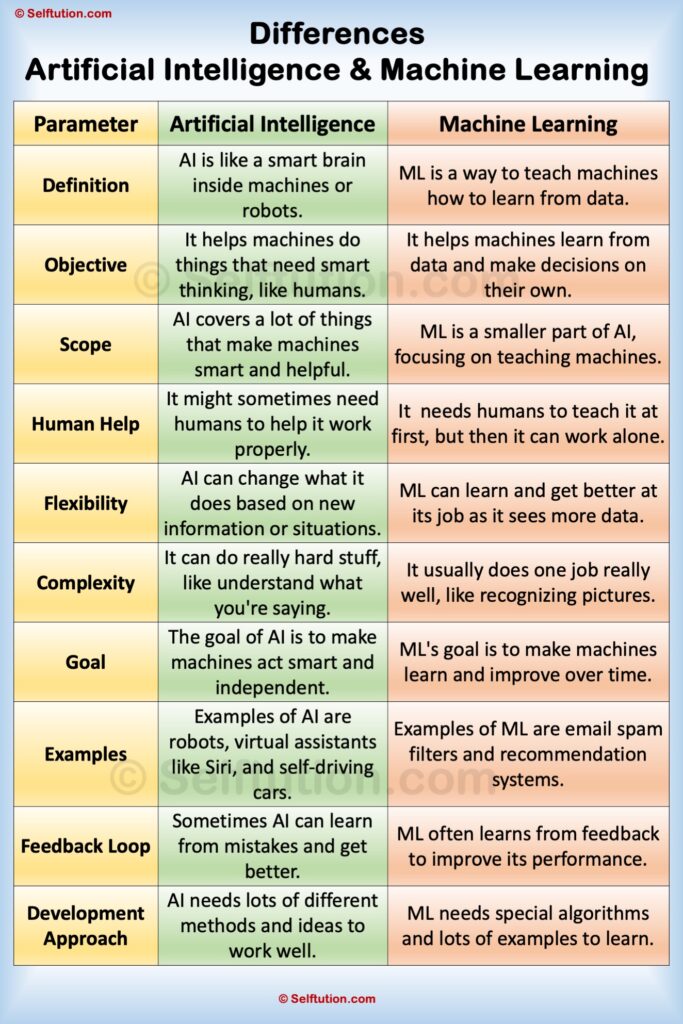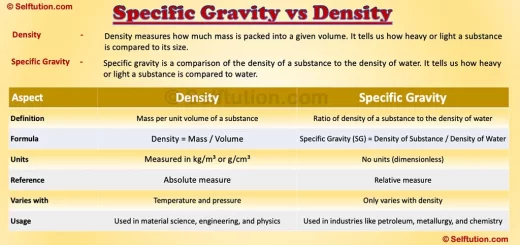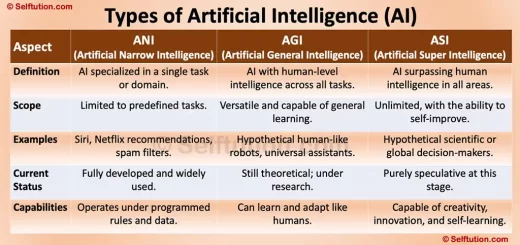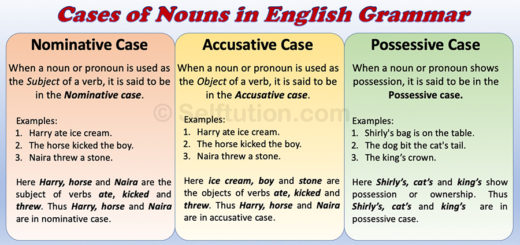Difference between Artificial Intelligence and Machine Learning
Artificial intelligence (AI) and machine learning are two amazing concepts that make our digital world come alive.
In this post, we’re going to explore the differences between AI and machine learning. So, buckle up, and let’s dive in!
What is Artificial Intelligence (AI)?
Artificial intelligence, or AI for short, is like the brain of a computer or a robot. It’s what makes them smart and capable of doing things that normally only humans can do.
AI can think, learn, and even make decisions all on its own!
Examples of Artificial Intelligence (AI)
- Virtual Assistants: Have you ever talked to Siri or Alexa? They’re examples of AI! They can answer your questions, play music, and even tell you jokes.
- Autonomous Vehicles: Self-driving cars use AI to navigate roads and avoid obstacles. They’re like robots that can drive themselves!
- Expert Systems: Some AI systems are experts in specific fields, like medicine or finance. They can give advice or help solve problems based on their knowledge.
What is Machine Learning?
Now, let’s talk about machine learning. Machine learning is a special kind of AI that focuses on teaching computers how to learn from data. It’s like giving them the ability to get smarter over time!
Examples of Machine Learning (ML)
- Email Spam Filters: Have you ever noticed that your email provider can detect spam? That’s because it’s using machine learning to learn from past emails and recognize patterns that indicate spam.
- Recommendation Systems: When you watch a movie on a streaming service and it suggests similar movies you might like, that’s machine learning at work. The more you watch, the better it gets at recommending!
- Predictive Analytics: ML algorithms can analyze data to make predictions. For example, they might predict how many people will buy a new product based on past sales data.
Key Differences Between Artificial Intelligence (AI) and Machine Learning
Now that we know what AI and machine learning are, let’s look at some key differences between them.
1. Learning Approach:
- Artificial Intelligence (AI) mimics human intelligence using techniques like rule-based programming and learning from data, while machine learning (ML) focuses on algorithms that help computers learn from data to make predictions or decisions.
2. Objective:
- AI aims to create systems with human-like intelligence for tasks like language understanding and object recognition, while ML focuses on developing algorithms that enable computers to learn and improve in tasks like prediction and classification.
3. Scope:
- Artificial Intelligence (AI) encompasses a broad range of techniques and applications that mimic human intelligence, while machine learning (ML) focuses on developing algorithms that enable computers to learn from data and improve on specific tasks.
4. Human Intervention:
- AI systems may or may not require human intervention for decision-making, while ML algorithms need human input for training but can make autonomous decisions once trained.
5. Adaptability:
- Artificial Intelligence (AI) systems can adapt and make real-time decisions based on changing inputs, while machine learning (ML) models improve over time by learning from new data and experiences.
6. Complexity:
- AI systems can handle complex tasks involving reasoning, problem-solving, and understanding language or context, while ML algorithms are designed for specific tasks like classification, regression, or clustering.
7. Feedback Loop:
- Artificial Intelligence (AI) systems may or may not incorporate a feedback loop for continuous improvement, while machine learning (ML) models typically do, adjusting performance based on feedback to enhance their accuracy and effectiveness.
8. Development Approach:
- AI development involves a combination of rule-based programming, machine learning techniques, and other methods to achieve human-like intelligence, while ML development focuses on selecting algorithms, training data, and fine-tuning parameters to enhance task performance.
Here’s a simplified version of the key differences between artificial intelligence (AI) and machine learning (ML) for kids presented in a tabular format:

Differences between Artificial Intelligence (AI) & Machine Learning (ML)
These simple explanations should help kids understand the basic differences between artificial intelligence and machine learning.
Conclusion: Exploring the Exciting World of Artificial Intelligence and Machine Learning
In this chapter, we’ve learned that artificial intelligence (AI) and machine learning (ML) are incredible technologies that make our digital world smarter and more capable. While AI focuses on creating systems with human-like intelligence, ML teaches computers how to learn from data and improve their performance over time. Understanding the differences between AI and ML helps us appreciate their unique roles and contributions to making our lives easier and more exciting!
You may also like…... Types of Chemical Reactions in Chemistry








